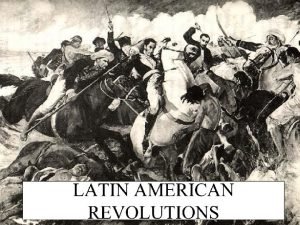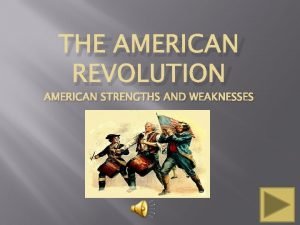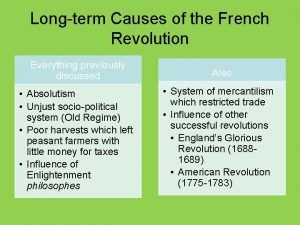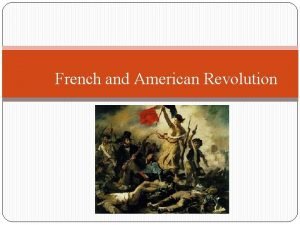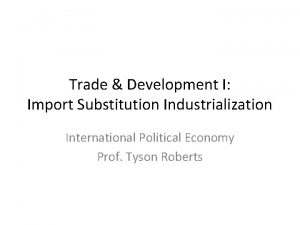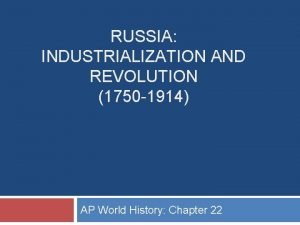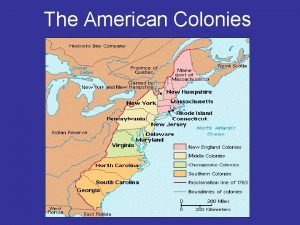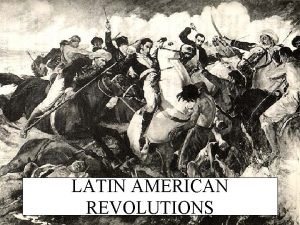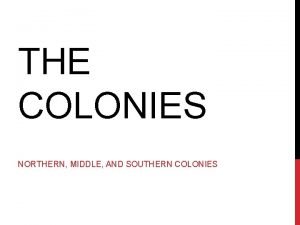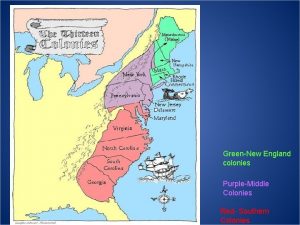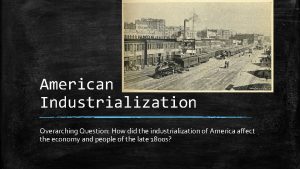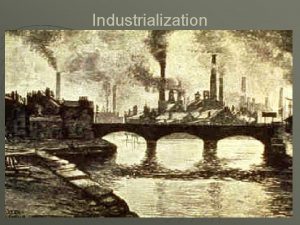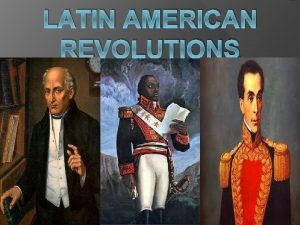Latin American Industrialization Causes As colonies Latin American



















- Slides: 19

Latin American Industrialization

Causes �As colonies Latin American territories had been prevented from developing manufacturing �Reliance on slave labor had prevented agricultural technology �Latin American states had history of successful agricultural production and access to natural resources

Causes � Latin American states gained independence AFTER W. Europe began industrialization � By the mid-1850’s, many countries in Latin America became more stable integrated into the world economy driven by the industrialization of the U. S. and Western Europe � Industrialized countries needed food products, raw materials, and markets to sell goods New Latin American state served as all 3 � This made it hard to compete copy W. European industrialization

Characteristics �Quickly developed in Export Economies providing: �Huge amounts of cash crops/food items Such as wheat, beef, sugar, coffee, fruits, ect �Mined natural resources Such as silver, copper, tin, ect �In exchange for these goods, Latin American countries received: textiles, machinery, tools, weapons, and luxury goods from Europe and the U. S.

Characteristics �European countries and the U. S. also invested capital in Latin America Mostly to build railroads there to help funnel exports to the coast �Many U. S. companies allied with landowners and politicians in Latin America to set up businesses there “New form of colonialism” indirect, behind the scenes power exercised by foreign investors

Characteristics � 90% of its population in an impoverished lower class Very small market for manufactured goods �Landowners benefitted so much Depiction of the lower class supporting the upper classes from exporting goods=little incentive to invest in manufacturing �No tariffs on foreign products – so domestic manufacturing companies couldn’t compete

Characteristics �Latin American urban workers created mutual aid societies, organized unions, and engaged in strikes to protest their harsh work environment and conditions �Authoritarian governments acted harshly to crush unions and strikes A crowd of Mexican workers being addressed during the miners’ strike in 1906 Wanted stability and progress in Latin America

Russian Industrialization

Causes �Russian Empire lost the Crimean War to an alliance of Western Europe, largely due to their industrial and technological weakness Motivated Russian government to initiate industrialization

Causes � 1861 = Russian state abolished serfdom (by Alexander II) �Stimulated by its defeat in the Crimean War Tsar Alexander II saw the defeat of Russia’s serf-army at the hands of FREE British and French troops as a sign to end serfdom �Hoped that recently free peasants would succeed in agriculture and created capital for industrialization

Causes �After the abolition of serfdom, Russia began a program of industrial development �Government Supported Industrialization: Began the Trans-Siberian Railroad Encouraged foreign investment Switched to the gold standard STATE-GUIDED INDUSTRIALIZATION!!!!



Characteristics � 1890 s = industrialization under way and growing rapidly �Focused on railroads and heavy industry �By 1900 = Russia ranked 4 th in the world in steel production

Characteristics �Had major industries: �iron/steel, coal, textiles, and oil

Characteristics �Government controlled and bought most of the heavy industry produced �Like Western Europe Russia developed a positive feedback loop Coal->Iron/steel->Railroad ->Coal

Characteristics � Factory workers made about 5% of total Russian population � Factory and urban life were AWFUL 13 -hour work day Ruthless discipline and constant disrespect from supervisors Lived in poorly constructed dorms � Most lived in large, unsanitary barracks � Unions and political parties illegal Only way to protest was through large-scale strikes

Characteristics �Growing middle class, A Family at Table, 1938 Painting of a Middle-Class Russian Family comprised of businessmen and professionals developed �Many objected to tsarist Russia and wanted a greater role in political life �But, the middle class was also dependent on the state for: contracts, jobs, and suppressing the growing radicalism of the workers

Characteristics �Many workers and educated Russians turned to Marxist socialism � 1898 = illegal Russian Social-Democratic Labor Party created Got involved in: workers’ education, union organizing, and revolutionary action � 1905 = a revolution in Russia erupted
 Industrialization
Industrialization Industrialization causes
Industrialization causes Causes of latin american revolution
Causes of latin american revolution Proximate and ultimate causes of behaviour
Proximate and ultimate causes of behaviour Ultimate vs proximate causation
Ultimate vs proximate causation Colonial states
Colonial states The american colonies emerge
The american colonies emerge Main causes of the american revolution
Main causes of the american revolution Causes and effects of american revolution
Causes and effects of american revolution American revolution causes and effects
American revolution causes and effects American revolution effect
American revolution effect Causes of the american revolution gallery walk
Causes of the american revolution gallery walk A thousand splendid suns in spanish
A thousand splendid suns in spanish Spanish american war causes
Spanish american war causes Import substitution industrialization
Import substitution industrialization Duma definition ap world history
Duma definition ap world history Industrialization aphg definition
Industrialization aphg definition Chapter 25 section 3 industrialization spreads
Chapter 25 section 3 industrialization spreads Chapter 9 section 3 industrialization spreads
Chapter 9 section 3 industrialization spreads Chapter 9 section 3 industrialization spreads answer key
Chapter 9 section 3 industrialization spreads answer key


